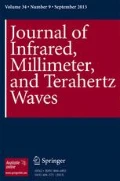Abstract
Based on analyzing the infrared laser’s transmitting characteristic in the seawater, the concept about the red tide infrared scattering coefficient is introduced. By analyzing the relationship between the red tide infrared scattering coefficient and the red tide’s density, we bring forward a new method of monitoring the red tide based on detecting the red tide infrared scattering coefficient. According to Mie scattering theory, the scattering efficiency factor and the scattering phase function of the red tide particles in the ocean are simulated and calculated. The result proves that, as the radiuses of the red tide particles increase, the scattering efficiency factor oscillates, and the swing decreases gradually, and then approaches to 2. From the results of the scattering phase function, it can find that the scattering of the red tide particles is mainly a forward scattering for the infrared laser. Therefore, by analyzing the scattering efficiency factor and the scattering phase function of the red tide particles in the ocean, it can prove the feasibility of this red tide monitoring method in theory.









Similar content being viewed by others
References
G. Daoming, Z. Xiuwen. Red tide disaster in coastal waters of China and its prevention suggestions. Marine Environmental Science 22(2), 60–63 (2003)
H. Chuanmin, F. E. Muller-Karger. Red tide detection and tracing using MODIS fluorescence data: a regional example in SW Florida coastal waters. Remote Sens. Environ. 97, 311–321 (2005)
J. Ishizaka. Detection of red tide events in the Ariake Sound, Japan. Ocean Remote Sensing and Application. SPIE 4892, 264–268 (2003)
H. Weigen, L. Xiulin. Satellite remote sensing for red tide detection and monitoring in China. Ocean Remote Sensing and Application. SPIE 4892, 258–263 (2003)
P. Delu. Satellite marine remote sensing in China. Remote Sensing Instruments and Applications. SPIE 4892, 1–16 (2003)
Y. H. Ahn, P. Shanmugam. New method for detecting red tide algal blooms in high scattering and absorbing waters using satellite ocean color imagery. Remote Sensing of the Coastal Oceanic Environment. SPIE 58850J, 1–10 (2005)
W. Markager, W. F. Vincent. Spectral light attenuation and absorption of UV and blue light in natural waters. Limnol. Oceanogr. 45(3), 642–650 (2000)
M. Yi, Z. Jie. A preliminary research on dominant species identification of red tide organism by airborne hyperspectral technique. Ocean Remote Sensing and Application. SPIE 4892, 278–286 (2003)
L. Yuzhong, Z. Jie. Advance in marine technique and application research of airborne hyperspectral remote sensing in China. Multispectral and hyperspectral remote sensing instruments and applications. SPIE 4897, 44–50 (2003)
P. Delu, M. Zhihua. Atmospheric correction for China’s coastal water color remote sensing. Acta Ocanogol. Sin. 20(3), 343–354 (2001)
R. Adachi. A taxonomical study of the red tide organisms. J Fac Fish Pref Univ Mie. 9, 9–145 (1972)
H. Takayama, R. Adachi. Gymnodinium nagasakiense sp. nov., a red tide forming dinophyte in the adjacent waters of Japan. Bull. Plankton Soc. Japan 31, 7–14 (1984)
C. Feng, C. Liangyi, X. Mingqiu. Analysis of absorption and scatter characteristics of the sea on airborne laser sounding. Acta Photonica Sinica 26(6), 561–565 (1997)
X. Qiyang, Y. Kuntao, W. Xinbing, et al. Blue-green lidar ocean survey. (National Defence Industry Press, Beijing, 2002), pp. 41–45.
Author information
Authors and Affiliations
Corresponding author
Rights and permissions
About this article
Cite this article
Hong, L., Tianlin, D., Yong, M. et al. The Study on Infrared Scattering of Red Tide. Int J Infrared Milli Waves 28, 305–314 (2007). https://doi.org/10.1007/s10762-007-9194-z
Received:
Accepted:
Published:
Issue Date:
DOI: https://doi.org/10.1007/s10762-007-9194-z




